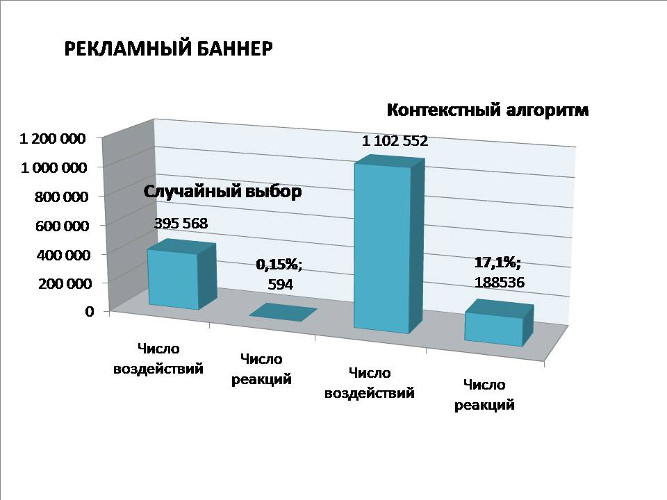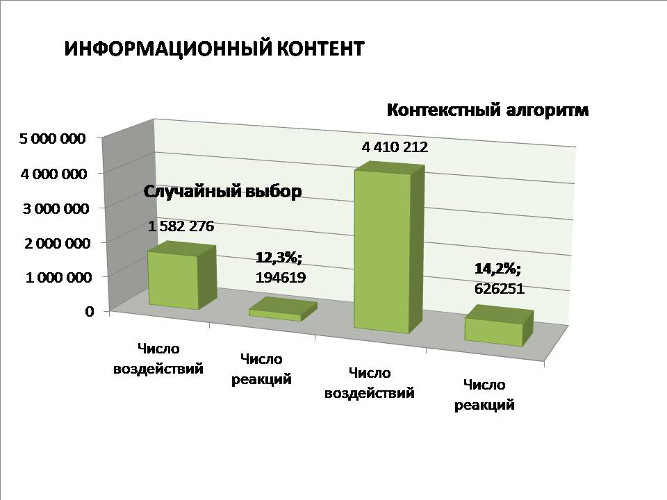The effectiveness of personal recommendations: a contextual approach
Personal recommendations, as the first stage of personalization of the Internet as a whole, are aimed at facilitating the search for information. But the expediency of their use remains quite controversial.
We had the opportunity to evaluate the effectiveness of the most popular approaches to the formation of recommendations to the user. Our system processed information received from several services (as partners), who offered their users recommendations of informational content and advertising banners and fixed the user's reaction to them (click / no click). Thus, for the analysis we received 13.4 million recommendations, formed on the basis of various methods.

The number of content recommendations offered to users. Other methods of recommending content included recommending popular content, content recommended by a user's friends, etc.
Most of the recommendations were formed using the context method. And no wonder, this is one of the most popular recommendation methods on the market, which has several advantages.
')
According to our data, recommendations of advertising banners based on the contextual approach, received 17% more positive reactions from users compared to recommendations that were formed randomly.

The effectiveness of contextual recommendations advertising content
The number of positive reactions to recommendations of informational content (articles, news) is 1.9% more than the responses to random recommendations.

The effectiveness of contextual recommendations of information content
For comparison - the permissible error of our system is 2.4% of the entire array of processed data. Therefore, we will not talk about the effectiveness of the contextual method in the field of informational proposals, but note that the effectiveness of the contextual approach for recommending advertising content is already worth discussing.
Recall that the essence of this method in the proposal to the user of content similar to the one that had previously caused the user a positive reaction. For the suggestion of “similar content,” the context method relies on the keywords assigned to the content. Part of the effectiveness of his recommendations may be lost due to errors in identifying similarities between two units of content. Another factor that may reduce the effectiveness of recommendations is the inability to go beyond the scope of those information about which is available to the service on the user's previous activity. Let us recall Artemy Lebedev, who successfully described the logic of contextual advertising in the phrase: “here are your shoes, you bought shoes”. For products that cannot be consumed by the user on a regular basis, this approach is ineffective. Offering the same informational content is even less justified - since the consumption of information is more diverse and dynamic than the buying activity.

Contextual recommendation method locks users in several topics.
These problems lie in the field of implementation and with the development of contextual algorithms can be eliminated. But there are problems that cannot be eliminated by the refinement and improvement of algorithms, since they are due to the peculiarities of the very principle of the context method. We believe that such a conceptual flaw is the lack of analysis of the individual characteristics of the user when making predictions of choice.
In its recommendations, the context operates on patterns of behavior that are due to the sociocultural characteristics of our society. For example, people go to foreign tours with cameras, they celebrate anniversaries in restaurants, for newborn girls they buy pink clothes, for boys - blue ones. But the number of such patterns is disproportionately less than the variety of reactions characteristic of people. Human behavior is not limited to a certain set of schemes. Each choice, each user action is due to its individual characteristics, current needs, internal resources that it has. Without finding out the underlying laws that force a person to perform a particular action, it is impossible to effectively predict his choices.
It is also true that, specifically for advertising purposes, so far there is enough knowledge about a person at the level that the contextual method owns. More precisely, the level to which he aspires. The contextual method is applicable, first of all, where there is an unambiguous chain of actions for most users, regardless of their personal characteristics, whereas the promotional offer is aimed at attracting a large number of consumers to the product. But the contextual approach to the methods of personalization can be attributed rather arbitrarily - the criteria for personal proposal presuppose individuality, focus on a particular person, her individual preferences, interests and needs, usual life scenarios, motives and desires.
The world in which we all live - our social habits, mentality, features of our life, of course, determine our actions, but our internal processes, motives and attitudes absolutely precisely define the world in which each of us lives. And the picture of the world of user-1 may differ significantly from the picture of the world of user-2, and even the notorious social trends that unite all of us are transformed into something completely individual in the psyche of everyone.
Therefore, being effective in the field of advertising proposals, the context method will not be successful in recommending informational content, as in other areas for which the importance of individuality is paramount - help in searching, dating, the formation of personal magazines and news feeds.
Thus, it should be recognized that the contextual method can be effectively applied in a number of areas, in particular in the field of promotional offers. It is unlikely that in the near future there will be a method of better selection of related products. It is possible to supplement the contextual approach with other algorithms, but, from our point of view, it is the context that will form at least 80% of the entire sentence.
However, you should not try to turn it into a panacea and solve problems related to personalization with it.
The article is written in collaboration: Oksana Khrebtova, Alexander Golovan.
We had the opportunity to evaluate the effectiveness of the most popular approaches to the formation of recommendations to the user. Our system processed information received from several services (as partners), who offered their users recommendations of informational content and advertising banners and fixed the user's reaction to them (click / no click). Thus, for the analysis we received 13.4 million recommendations, formed on the basis of various methods.

The number of content recommendations offered to users. Other methods of recommending content included recommending popular content, content recommended by a user's friends, etc.
Most of the recommendations were formed using the context method. And no wonder, this is one of the most popular recommendation methods on the market, which has several advantages.
')
According to our data, recommendations of advertising banners based on the contextual approach, received 17% more positive reactions from users compared to recommendations that were formed randomly.

The effectiveness of contextual recommendations advertising content
The number of positive reactions to recommendations of informational content (articles, news) is 1.9% more than the responses to random recommendations.

The effectiveness of contextual recommendations of information content
For comparison - the permissible error of our system is 2.4% of the entire array of processed data. Therefore, we will not talk about the effectiveness of the contextual method in the field of informational proposals, but note that the effectiveness of the contextual approach for recommending advertising content is already worth discussing.
Recall that the essence of this method in the proposal to the user of content similar to the one that had previously caused the user a positive reaction. For the suggestion of “similar content,” the context method relies on the keywords assigned to the content. Part of the effectiveness of his recommendations may be lost due to errors in identifying similarities between two units of content. Another factor that may reduce the effectiveness of recommendations is the inability to go beyond the scope of those information about which is available to the service on the user's previous activity. Let us recall Artemy Lebedev, who successfully described the logic of contextual advertising in the phrase: “here are your shoes, you bought shoes”. For products that cannot be consumed by the user on a regular basis, this approach is ineffective. Offering the same informational content is even less justified - since the consumption of information is more diverse and dynamic than the buying activity.

Contextual recommendation method locks users in several topics.
These problems lie in the field of implementation and with the development of contextual algorithms can be eliminated. But there are problems that cannot be eliminated by the refinement and improvement of algorithms, since they are due to the peculiarities of the very principle of the context method. We believe that such a conceptual flaw is the lack of analysis of the individual characteristics of the user when making predictions of choice.
In its recommendations, the context operates on patterns of behavior that are due to the sociocultural characteristics of our society. For example, people go to foreign tours with cameras, they celebrate anniversaries in restaurants, for newborn girls they buy pink clothes, for boys - blue ones. But the number of such patterns is disproportionately less than the variety of reactions characteristic of people. Human behavior is not limited to a certain set of schemes. Each choice, each user action is due to its individual characteristics, current needs, internal resources that it has. Without finding out the underlying laws that force a person to perform a particular action, it is impossible to effectively predict his choices.
It is also true that, specifically for advertising purposes, so far there is enough knowledge about a person at the level that the contextual method owns. More precisely, the level to which he aspires. The contextual method is applicable, first of all, where there is an unambiguous chain of actions for most users, regardless of their personal characteristics, whereas the promotional offer is aimed at attracting a large number of consumers to the product. But the contextual approach to the methods of personalization can be attributed rather arbitrarily - the criteria for personal proposal presuppose individuality, focus on a particular person, her individual preferences, interests and needs, usual life scenarios, motives and desires.
The world in which we all live - our social habits, mentality, features of our life, of course, determine our actions, but our internal processes, motives and attitudes absolutely precisely define the world in which each of us lives. And the picture of the world of user-1 may differ significantly from the picture of the world of user-2, and even the notorious social trends that unite all of us are transformed into something completely individual in the psyche of everyone.
Therefore, being effective in the field of advertising proposals, the context method will not be successful in recommending informational content, as in other areas for which the importance of individuality is paramount - help in searching, dating, the formation of personal magazines and news feeds.
Thus, it should be recognized that the contextual method can be effectively applied in a number of areas, in particular in the field of promotional offers. It is unlikely that in the near future there will be a method of better selection of related products. It is possible to supplement the contextual approach with other algorithms, but, from our point of view, it is the context that will form at least 80% of the entire sentence.
However, you should not try to turn it into a panacea and solve problems related to personalization with it.
The article is written in collaboration: Oksana Khrebtova, Alexander Golovan.
Source: https://habr.com/ru/post/209554/
All Articles